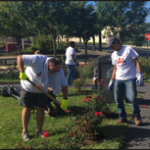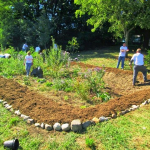New Jersey Future Blog
NJ Residents can Improve Flood Management, one Rain Garden at a Time
November 1st, 2021 by Andrew Tabas
Flooding is a critical issue at all scales. On individual properties, flooding can cause a range of problems, from the risk of pooled water freezing and becoming a slipping hazard to serious damage in basements and ground floors. At the regional level, low-lying areas are vulnerable to severe damage from stormwater that accumulates as it flows downhill. Last month, the remnants of Hurricane Ida reminded New Jersey residents of how impactful flooding can be.
Water engineers tell us that individual community members can work together to solve this problem by building rain gardens. Rain gardens, a type of green infrastructure, are designed to soak up water during storms. On properties with rain gardens, this means less pooled water and more groundwater recharge. The more properties adopt this practice, the more pressure is relieved from the area’s municipal separate storm sewer system or combined sewer system, helping to reduce the extent of flooding downstream.
I decided to build my own rain garden to apply what I have learned through my work on New Jersey Future’s Mainstreaming Green Infrastructure program. The process gave me a better understanding of green infrastructure and how it can bring both stormwater management and aesthetic benefits.
Follow these steps to build a rain garden in your backyard, school, religious institution, municipal building, or other space!
- Plan the rain garden. Start by identifying where you see stormwater collect during storms. Is there a downward-sloping driveway? Does rainwater collect in roof gutters? Use this information to choose the perfect location for the rain garden.
- Make a design for your rain garden. The more stormwater the rain garden needs to treat, the larger it needs to be. Rutgers University’s Rain Garden Manual of New Jersey is a great resource for designing your rain garden.
- Conduct a soil infiltration test to see how well water will drain from the proposed site. Chapter 2 of Rutgers University’s Rain Garden Manual of New Jersey has instructions for how to conduct the soil infiltration test.
- Choose your plants. These should be native plants that can handle large volumes of water.
- Implement your design. Remove grass and soil to the required depth. To make sure that the bottom of the rain garden follows the slope of your design, use a tape measure to keep track of the height at various places in the rain garden.
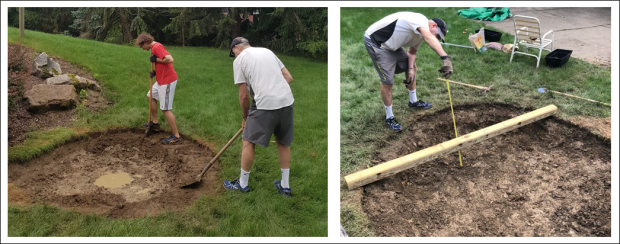
Digging and measuring the depth of the rain garden.
- If the infiltration test indicated that the site drains slowly, add a layer of sandy soil to the site. This will increase the infiltration rate (the speed at which water soaks into the ground).
- Add plants, leaving space between plants so that they can grow over time.
- Add a layer of mulch. The top of the mulch should still be below ground level on the surrounding lawn. See Chapter 3 of Rutgers University’s Rain Garden Manual of New Jersey for additional installation guidance.
- Sustain your creation. Watering and weeding wil help your plants thrive.
- Conduct annual maintenance, including pruning and mulching. Chapter 4 of Rutgers University’s Rain Garden Manual of New Jersey has additional instructions on how to sustain a healthy rain garden.
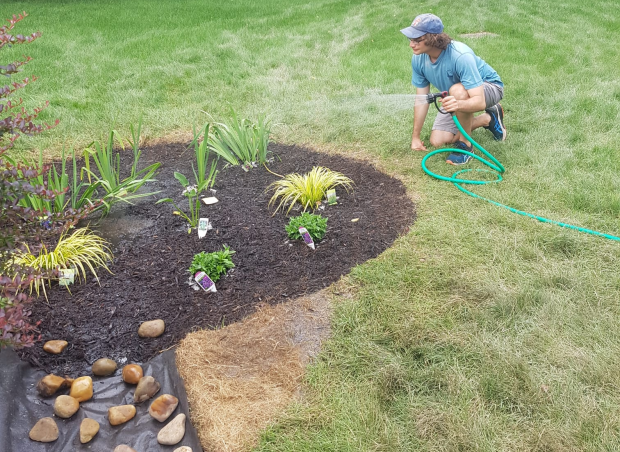
Maintenance is critical to ensure that green infrastructure is effective. Watering the rain garden shortly after installation will help the plants establish themselves.
Building a rain garden taught me several valuable lessons about green infrastructure. First, leave plenty of time for digging and use hand protection. Removing the required amount of soil took several days of digging with shovels and pickaxes. Second, ask an expert to weigh in on your design. Chris Obropta and Liz Pyshnik at Rutgers University provided valuable insight during the design process. Third, use a tarp to keep stormwater from filling the rain garden during construction. Otherwise, the space will fill up like a bathtub and it will be difficult to continue construction. Fourth, choose native plants that can cope with both flooding and drought. Irises, New England asters, decorative grasses, and arrow arum fulfilled these goals for my rain garden in Pittsburgh, PA.
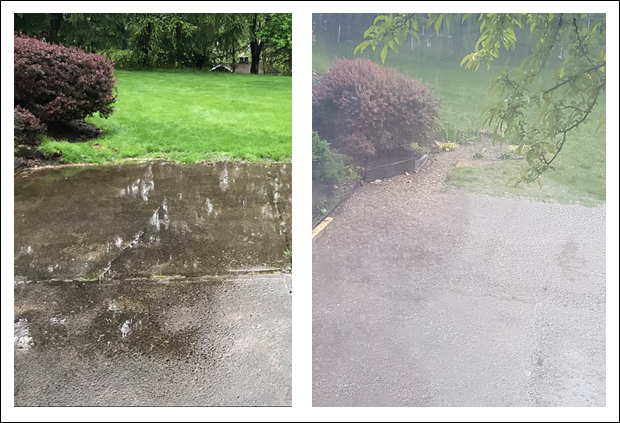
Before the rain garden was constructed (left), water would pool in the driveway. After construction (right), the water has a place to go during storms. The rain garden is typically dry within 24 hours of storms.
While rain gardens look great and prevent flooding, they can also save money! The Clean Stormwater and Flood Reduction Act, passed in 2019, permits NJ localities to create stormwater utilities. Part of the design of a stormwater utility is that properties that construct green infrastructure become eligible for a discount. The rain garden that I built was in a neighborhood of Pittsburgh with a stormwater fee of $8/month. After the township inspected the rain garden, the monthly fee was reduced to $5.60/month, a savings of 30%. To learn more about strategies to incentivize green infrastructure, read this memo by the Jersey Water Works Green Infrastructure Committee.
To get started building rain gardens in your town:
- Build a rain garden in your backyard, school, religious institution, municipal building, or other space!
- Sign up for the Green Infrastructure Champions Program to learn new advocacy strategies.
- Encourage your municipal leaders to update your town’s Stormwater Ordinance to require green infrastructure on development projects.
- Visit the New Jersey Green Infrastructure Municipal Toolkit to learn more.
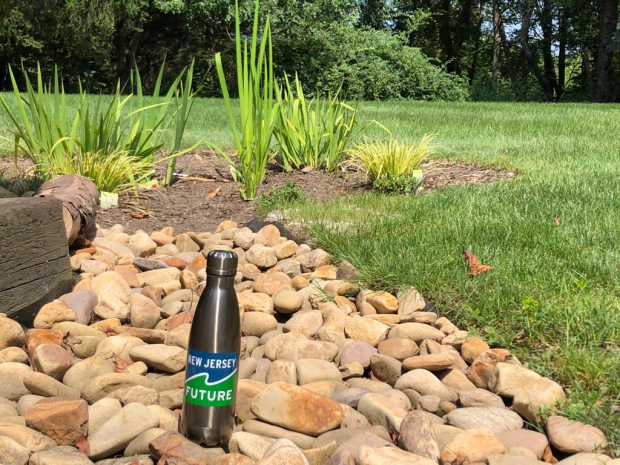
The completed rain garden.
You, too, can bring flood prevention, stormwater runoff quality treatment, and aesthetic improvements to your property by building a rain garden. Special thanks to Gary Tabas, Debra Tabas, Dorothy Heinrich, Liz Pyshnik, and Chris Obropta for their help with this project.
Related Posts
Tags: flooding, green infrastructure, rain garden, Stormwater

